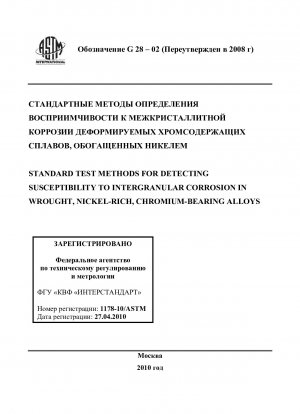ASTM G28-02(2008)
Standard Test Methods for Detecting Susceptibility to Intergranular Corrosion in Wrought, Nickel-Rich, Chromium-Bearing Alloys
- Standard No.
- ASTM G28-02(2008)
- Release Date
- 2002
- Published By
- American Society for Testing and Materials (ASTM)
- Status
- Replace By
- ASTM G28-02(2015)
- Latest
- ASTM G28-22
- Scope
The boiling ferric sulfate-sulfuric acid test may be applied to the following alloys in the wrought condition:
Alloy Testing Time, h N06007 120 N06022 24 N06030 120 N06059 24 N06200 24 N06455 24 N06600 24 N06625 120 N06686 24 N06985 120 N08020 120 N08367 24 N08800 120 N08825A 120 N10276 24 ____________ A While the ferric sulfate-sulfuric acid test does detect susceptibility to inter- granular corrosion in Alloy N08825, the boiling 65 % nitric acid test, Practices A 262
, Practice C, for detecting susceptibility to intergranular corrosion in stainless steels is more sensitive and should be used if the intended service is nitric acid. This test method may be used to evaluate as-received material and to evaluate the effects of subsequent heat treatments. In the case of nickel-rich, chromium-bearing alloys, the test method may be applied to wrought and weldments of products. The test method is not applicable to cast products.
1.1 These test methods cover two tests as follows:
1.1.1 Method A, Ferric Sulfate-Sulfuric Acid Test (Sections 3-10, inclusive)8212;This test method describes the procedure for conducting the boiling ferric sulfate—50 % sulfuric acid test which measures the susceptibility of certain nickel-rich, chromium-bearing alloys to intergranular corrosion (see Terminology G 15
), which may be encountered in certain service environments. The uniform corrosion rate obtained by this test method, which is a function of minor variations in alloy composition, may easily mask the intergranular corrosion components of the overall corrosion rate on alloys N10276, N06022, N06059, and N06455. 1.1.2 Method B, Mixed Acid-Oxidizing Salt Test (Sections 11-18, inclusive)8212;This test method describes the procedure for conducting a boiling 23 % sulfuric + 1.2 % hydrochloric + 1 % ferric chloride + 1 % cupric chloride test which measures the susceptibility of certain nickel-rich, chromium-bearing alloys to display a step function increase in corrosion rate when there are high levels of grain boundary precipitation.
ASTM G28-02(2008) Referenced Document
- ASTM A262 Standard Practices for Detecting Susceptibility to Intergranular Attack in Austenitic Stainless Steels
- ASTM D1193 Standard Specification for Reagent Water
- ASTM G15 Standard Terminology Relating to Corrosion and Corrosion Testing
ASTM G28-02(2008) history
- 2022 ASTM G28-22 Standard Test Methods for Detecting Susceptibility to Intergranular Corrosion in Wrought, Nickel-Rich, Chromium-Bearing Alloys
- 2002 ASTM G28-02(2015) Standard Test Methods for Detecting Susceptibility to Intergranular Corrosion in Wrought, Nickel-Rich, Chromium-Bearing Alloys
- 2002 ASTM G28-02(2008) Standard Test Methods for Detecting Susceptibility to Intergranular Corrosion in Wrought, Nickel-Rich, Chromium-Bearing Alloys
- 2002 ASTM G28-02 Standard Test Methods of Detecting Susceptibility to Intergranular Corrosion in Wrought, Nickel-Rich, Chromium-Bearing Alloys
- 1997 ASTM G28-97 Standard Test Methods of Detecting Susceptibility to Intergranular Corrosion in Wrought, Nickel-Rich, Chromium-Bearing Alloys
